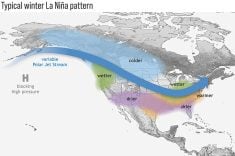Colleen Littlejohn considers her employer the best-kept secret in Canada.
“We need to get our word out to the Canadian public,” said Littlejohn, director of programs for Save the Children Canada.
The foreign aid group has been on clean-up duty for the last few years, rebuilding communities after Hurricane Mitch in Central America, the 1998 earthquake in Bolivia and the drought in the southern Sudan.
The need to spend money on communications rather than programs is an issue facing all foreign aid agencies in Canada. The groups have been forced to look to the public for donations after the federal government began slashing funding in 1995.
Read Also

Canadian Food Inspection Agency extends chronic wasting disease control program consultation deadline
Date extended for consultation period of changes to CWD program
Littlejohn said her agency has now widened its funding base to one-third from government, one-third from individuals and one-third from other activities. It raises $10 million annually for child-focused projects in nine countries.
Time is worth money
Although farmers are cash poor, Littlejohn said they can still contribute their time as volunteers for fundraising and public education. It is especially critical for farmers to understand the foreign aid link since most people in the developing world live in rural areas, she said.
“When it’s hard times in Canada, it is more difficult to get donations. Also, you must make the links between economic issues in Canada and the developing world.”
One of the ways to do that is to highlight child rights. Littlejohn said the 10-year-old United Nations agreement on the rights of children has been signed by every country except Somalia and the United States. But signing the deal is not enough, she said. Groups like hers educate people about children’s rights to survival, protection, recreation and education.
The federal government made a commitment in 1989 to eradicate child poverty in this country by 2000. However, a review in 1997 showed the number of poor kids has increased by 58 percent. And it was a Canadian teenager who publicized the connection between Asian child labor and clothing sold in Canadian stores.
For more information contact the agency at 800-668-5036.














